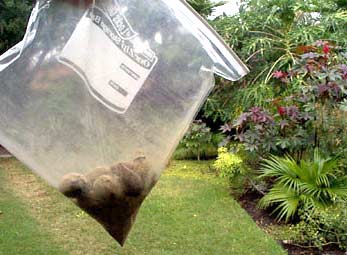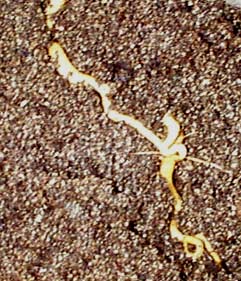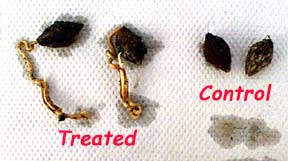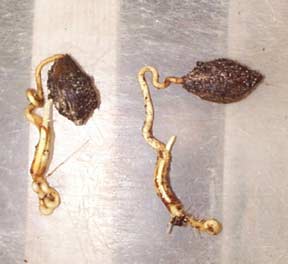Testing the effects on
seed germination using Aspergillus inoculate
(Syagrus cearensis)
Abstract
Although by far, this is not
a scientific experiment, it is however designed to show some
of my fellow palm and tropical gardening enthusiast & friends,
the results I obtained using Aspergillus in the
seed germination process.
As many of us already know, germinating certain seed, especially
those in the Palmae family, can take many months and even
years in some cases for the radicle and first plumule to form.
In this test, I'm attempting to analyze and document the progress,
as to the length of time it takes, plus the quantity of seed
in each case that do germinate of the species, Syagrus
cearensis, using seed treated with Aspergillus
and a Control set with out the seed being treated. And finely
by checking the root system for any unusual growth, by comparing
both the treated and untreated plants.
Bottom line: To determine if Aspergillus
aids and enhances seed germination and plant development.
The Set up
I used a plastic covered tray
6 1/2 inches by 5 inches and filled with sterilized seed starting
mix. 2 Syagrus cearensis seeds were put into a
baggy with a teaspoon of Aspergillus inoculate
and agitated until all seed were completely covered with substance,
these were than planted in a sterile seed starting soil. 2 Syagrus
cearensis seed were used as a control. Trays were watered
and placed in a warm but dark area. No bottom heat was used and
I only watered once, about 20 days into the experiment. Trays
are inspected at least once a week.
Note: All four (4) seed used
in this experiment were collected at the Montgomery Botanical
Center in Miami Florida, September 2000. No fertilizer or plant
stimulants were used whatsoever including EcoSane, HB-101, B1
or any other plant hormones.
In the Past
We have all tried the baggy method
or in the pot, (they either grow or else they rot) method, with
some and some not-so successful results. Bottom heat is usually
recommended and it certainly wouldn't hurt in speeding up seed
germination. But usually we fall short of our expectations, our
special palm seed, that we dreamed someday towering over head,
for all the world to see, doesn't happen like we planed. Sometimes
we forget to water and as time goes by we seem to forget about
what we did back 6 months ago and when we do remember we find
a disappointing dried pot or dry moldy seed left in our long
forgotten baggy. We must try and check each and everyday our
seed, in order to accomplish our mission.
Events

Aspergillus being applied to Attlea liebmannii and
Syagrus cearensis seed November 19, 2000 |

Trays were inspected on January
20th and noted; A radicle and long roots were observed through
the clear plastic tray on the treated seed, also noted were the
absence of any root or activity in the control set. It has now
been two months from time of sowing. |

Syagrus cearensis; On the
left are the two treated seed that were removed from the tray
and transplanted into larger containers. To the right are the
two untreated seed (controls) that were returned to the germination
tray. |

Syagrus cearensis: Close
up of germinated seed that were treated with Aspergillus.
Image taken January 26, 2001 |
Conclusion
Some
of the things I do,
to lose those winter time Blues!
|
|



